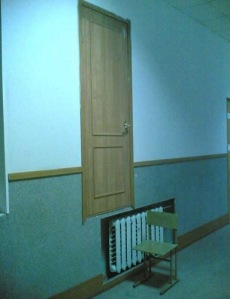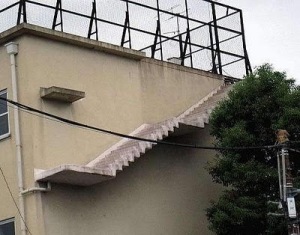 When entering a burning structure time is of the essence. In a regular run of the mill fire all will go well. But there are sometimes that we have speed bumps that get in the way. Most are due in part to things that go wrong in the operation, equipment malfunction, water supply problems and personnel shortage, which are things that we can prevent. But what if those things are out of our hands? What if they were speed bumps that were placed way before the emergency ever panned out? I am talking about building errors that happened during the construction of the building. Can we as a department have prevented them? Before we can discuss the prevention we need to take a look at the problem. I have found some examples of what I am talking about:
When entering a burning structure time is of the essence. In a regular run of the mill fire all will go well. But there are sometimes that we have speed bumps that get in the way. Most are due in part to things that go wrong in the operation, equipment malfunction, water supply problems and personnel shortage, which are things that we can prevent. But what if those things are out of our hands? What if they were speed bumps that were placed way before the emergency ever panned out? I am talking about building errors that happened during the construction of the building. Can we as a department have prevented them? Before we can discuss the prevention we need to take a look at the problem. I have found some examples of what I am talking about:
 It appears that someone forgot to add a balcony or stairs to the other side of this door. While performing a search of rooms, do you take the time to feel the floor before entering a new room through a doorway? This has uh oh written all over.
It appears that someone forgot to add a balcony or stairs to the other side of this door. While performing a search of rooms, do you take the time to feel the floor before entering a new room through a doorway? This has uh oh written all over.
 While not as dramatic of a drop, this still is enough to leave a mark and a few days off.
While not as dramatic of a drop, this still is enough to leave a mark and a few days off.
 While I am not in the construction industry, in fact the best thing I ever built was a table for my sons trains to run on, I am pretty sure that those floor joists are supposed to actually be seated all the way down. Also I think maybe just maybe they should have some sort of anchoring system in place to keep them there. While sounding the floor to check for stability is a must, I don’t think that would help very much in this situation. With the already existent floor load from household furnishings bearing weight on these what do you think the added weight of two firemen in full gear and a charged hose line would do?
While I am not in the construction industry, in fact the best thing I ever built was a table for my sons trains to run on, I am pretty sure that those floor joists are supposed to actually be seated all the way down. Also I think maybe just maybe they should have some sort of anchoring system in place to keep them there. While sounding the floor to check for stability is a must, I don’t think that would help very much in this situation. With the already existent floor load from household furnishings bearing weight on these what do you think the added weight of two firemen in full gear and a charged hose line would do?
 If you were descending these stair in smoke filled conditions would you even think of the fact that there may just be a wall at the bottom. This is why feeling while crawling becomes so important. If you were to run into this during fire conditions would it disorient you?
If you were descending these stair in smoke filled conditions would you even think of the fact that there may just be a wall at the bottom. This is why feeling while crawling becomes so important. If you were to run into this during fire conditions would it disorient you?
 When in a commercial operation, malls and stores, some have a second story. When finding the escalator and climbing would you think that you would find this?
When in a commercial operation, malls and stores, some have a second story. When finding the escalator and climbing would you think that you would find this?
Not all building flaws are found inside either. Outside is just as important. With outdoor operations you wouldn’t think that there could be any speed bumps pretty clear cut and forward. But yet again I have examples of how you should always be on top of your game:
 When deploying resources to do interior attacks and searches during heavy smoke conditions would you want to ladder the lower balcony? Or would you just assume that there was a door there and deploy?
When deploying resources to do interior attacks and searches during heavy smoke conditions would you want to ladder the lower balcony? Or would you just assume that there was a door there and deploy?
 When confronted with outdoor steps would you step back and evaluate the entire set of stairs or would you charge full speed ahead?
When confronted with outdoor steps would you step back and evaluate the entire set of stairs or would you charge full speed ahead?
 When planning two forms of egress off of a roof would you see the step and plan on those as one? Once again take the time to step back and evaluate the entire picture rather then relying on tunnel vision.
When planning two forms of egress off of a roof would you see the step and plan on those as one? Once again take the time to step back and evaluate the entire picture rather then relying on tunnel vision.
 When determining apparatus placement do you take the time to look at all angles of your parking spot? While from the front this grade may not look steep from the side you can definitley see that there is a problem.
When determining apparatus placement do you take the time to look at all angles of your parking spot? While from the front this grade may not look steep from the side you can definitley see that there is a problem.
 Even when not operating on a fire ground scene we need to take time to evaluate surroundings. Does it look like these lines can handle the weight load that is placed on them?
Even when not operating on a fire ground scene we need to take time to evaluate surroundings. Does it look like these lines can handle the weight load that is placed on them?
Not all flaws are due to builder error though. Homeowners have a strange habit of doing weird things to their homes in order to make or save money:
 Here we have a resteraunt which someone had decided to open up in their home. By doing so they added elements to a residential based operation that we usually reserve for commercial based attacks.
Here we have a resteraunt which someone had decided to open up in their home. By doing so they added elements to a residential based operation that we usually reserve for commercial based attacks.
 Here we have a homeowner who decided that their hot water heater was an eye sore in the home, so they moved it to the backyard.
Here we have a homeowner who decided that their hot water heater was an eye sore in the home, so they moved it to the backyard.
 Here we have a built in grease trap that someone set into the ground. If you were operating onthe scene and stepped into it then entered the structure that is involved, what do you think the outcome would be?
Here we have a built in grease trap that someone set into the ground. If you were operating onthe scene and stepped into it then entered the structure that is involved, what do you think the outcome would be?
 And finally here we have someone that didn’t feel the need to cut down the tree that was growing out of their basement. This adds a whole new dimension to a collapse zone in the event of a fire.
And finally here we have someone that didn’t feel the need to cut down the tree that was growing out of their basement. This adds a whole new dimension to a collapse zone in the event of a fire.
So how are these speed bumps preventable? Yes they are. This is why as a department inspections are key. While some of these are impossible to inspect, as in the residential problems, there are ways to do a brief inspection upon arrival of an incident. We do it everyday, in fact they preach it everyday in the classrooms training the future of the service. Gloves On, Scene Safe…. are words muttered by students all over the country. When exiting the apparatus a size up or inspection needs to be done. Be aware of visual clues that may be seen. Ask the homeowner, I am oretty sure they would be able to tell you they have a tree sticking out of their basement. On the commercial side while building are being constructed drive past them occasionally look at how they are being erected. Ask the contractor if your department can do a walk through, I don’t think many of them will turn you away. Unless there are shady things going on behind newly constructed walls. Granted most of these pictures are not from the US, because we do have stricter building codes, but the speed bumps are always there no matter how big or small. Always be aware of your surroundings.
~Creek Medic

